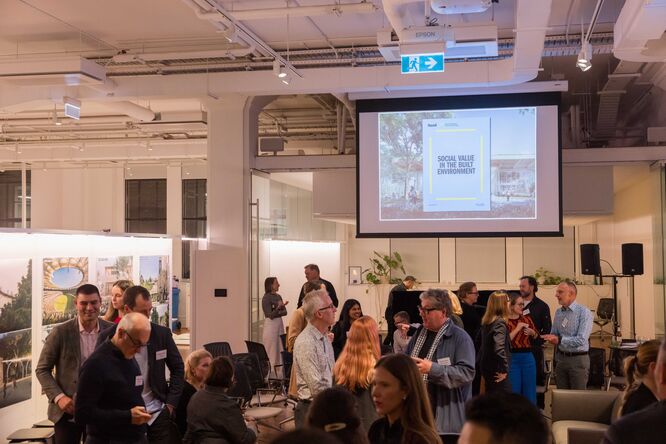Connection and care: Navigating social value in our built environment

Every new building, space or place has the potential to provide social value. This is just one of the key takeaways from our national series of events launching Social Value in the Built Environment, a new discussion paper by Hassell and Green Building Council of Australia (GBCA).
Earlier this year, Hassell and the Green Building Council of Australia (GBCA) launched the Social Value in the Built Environment discussion paper in Sydney. This kicked off a series of panel events across Brisbane, Melbourne and Perth. These events revealed a strong industry consensus on the importance of integrating social value early into the design process. It was also recognised that the built environment industry is still working to consistently achieve and measure the outcomes of social value. Here, we highlight five key insights from our experienced panellists, which shed light on shared challenges and approaches.
“What is the foundational element of social value? It’s as simple as connection and care for one another — even if we don’t know each other.”
— Lauren Kajweski, Director Sustainability & Learning, Landcom
WORKING WITH THE LOCAL COMMUNITY
Early engagement and collaboration with the community are essential for creating social value. By ensuring projects are relevant, supported and beneficial, we can enhance social cohesion, trust and sustainable development. Conducting a needs-assessment can effectively identify community priorities and challenges, guiding meaningful and impactful initiatives.
EARLY INTEGRATION AND CLEAR OUTCOME DEFINITIONS
Incorporating social value from the outset of a project enables a holistic approach that delivers wide-ranging benefits. For instance, integrating green spaces into project designs supports biodiversity, reduces urban heat island effects, and improves air quality. Green spaces also enhance physical and mental well-being by providing areas for recreation, relaxation and social interaction. Setting social value goals from the start provides a clear vision, guiding all stakeholders towards a common purpose and positive impact. It can enable opportunities such as developing metrics to measure progress and success, which can be quantitative and qualitative.
SHOW ME THE MONEY (BUT DON’T STOP THERE)
“Social performance is better understood by telling a holistic story of spend, impact, outcomes and hearing from those who participated, rather than trying to boil down a complex effort to one number.”
— Sarah Clarke, Group General Manager, Sustainability at Mirvac
Assigning a monetary value to social benefits can make the impact more tangible and easier to communicate, especially to stakeholders who prioritise financial metrics. However, this approach risks oversimplifying the true breadth and depth of social value. To truly capture and communicate the social value of a programme, it’s essential to delve deeper than just financial figures. The personal stories of the impact a project may have on people’s lives can inspire others to do the same or more.
EVERY PROJECT HAS POTENTIAL
“Social impact isn’t limited to projects that address social need. Every project has the capacity to imagine itself as something bigger, as part of the broader community.”
— Emma Williamson, Government Architect, Western Australia
Many assume that social impact is focused on addressing pressing issues such as poverty alleviation, education, or healthcare. However, every project, regardless of its primary focus, can contribute to social value. This perspective encourages a broader, more inclusive view of social impact. By imagining projects as part of a larger social ecosystem, developers can implement designs and practices that enhance social value, ultimately contributing to a more connected, sustainable, and vibrant community
GOVERNMENT LEADERHIP AND INDUSTRY COLLABORATION
“I encourage and challenge you that as you get learnings from this paper, push it out into government, push it out into other sectors and to your suppliers. The more people who are considering measuring social value means better outcomes for everyone.”
— Anders Uechtritz, Principal, Consulting, Social Venture Australia
Embedding social value in our built environment requires leadership from all levels of government but also collaboration across industry. The Measuring What Matters framework released by the Australian Government provides a great building block for developing common indicators to help guide state and local governments to set priorities and procurement requirement. Industry also needs to come together to not only create a shared definition and understanding of social value but develop common approaches to social value creation and measurement.
Discover more and DOWNLOAD THE DISCUSSION PAPER
日期

